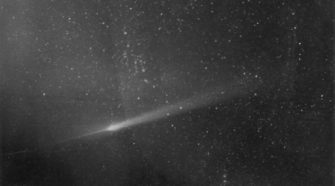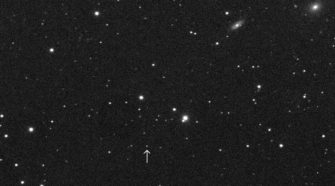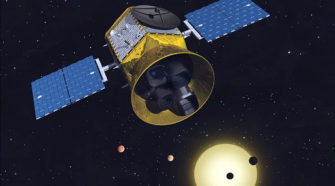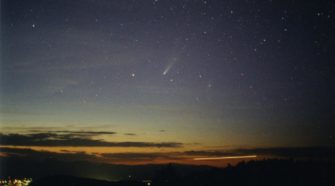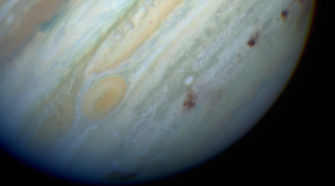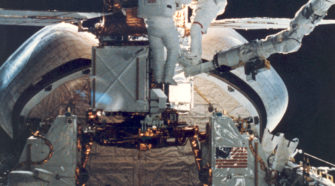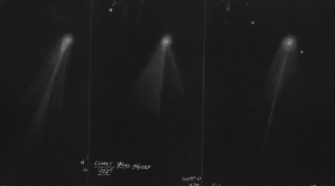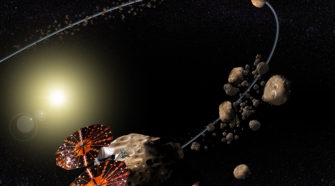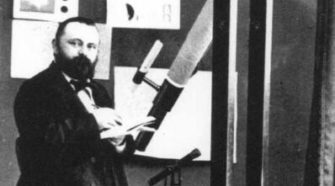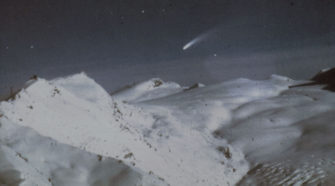Ice and Stone
Comet of the Week: Arend-Roland 1956h
Perihelion: 1957 April 8.03, q= 0.316 AU There weren’t any bright comets that appeared the year I was born, 1958, but two bright comets appeared the previous year. These two objects were the brightest comets to become easily visible from the northern hemisphere since the return of Comet 1P/Halley in 1910. The first of the …
Special Topic: Designations and Names of “Small Bodies”
Throughout “Ice and Stone 2020” I refer to numerous specific objects, including in all of my “Comet of the Week” presentations as well as in several of my “Special Topics” presentations and in the lists of weekly historical events. It is appropriate, then, to discuss how these various objects are designated and named. The conventions …
This Week in History: April 12-18
APRIL 13, 2029: The near-Earth asteroid (99942) Apophis will pass just 0.00026 AU from Earth, slightly less than 5 Earth radii above the surface and within the orbital distance of geosynchronous satellites. At this time this is the closest predicted future approach of a near-Earth asteroid. The process of determining future close approaches like this …
Comet of the Week: 153P/Ikeya=Zhang P/2002 C1
Perihelion: 2002 March 18.98, q = 0.507 AU One of the many successful Japanese comet hunters of the 1960s was Kaoru Ikeya who, coming from a family of modest means, built a homemade telescope for the equivalent of US$20 and began to hunt comets with it. He discovered his first comet in 1963 and would …
Special Topic: Prediction of Future Approaches
During the third week of July 1994 the various fragments of Comet Shoemaker-Levy 9 1993e impacted Jupiter, liberating enormous amounts of energy in the process and creating large planet-sized “scars” in Jupiter’s atmosphere that lingered for some time afterwards. (Comet Shoemaker-Levy 9 and these events are discussed in a future “Comet of the Week” presentation.) …
This Week in History: April 5-11
APRIL 5, 1861: An amateur astronomer in New York, A.E. Thatcher, discovers a 9th-magnitude comet. Comet Thatcher was found to have an approximate orbital period of 415 years and is the parent comet of the Lyrid meteor shower, which peaks around April 22 each year. The Lyrids usually put on a modest display of less …
Comet of the Week: 12P/Pons-Brooks
Perihelion: 2024 April 21.00, q = 0.781 AU For this week’s “Comet of the Week” I am turning my eye towards the near-term future: a comet that I hope to see within the next few years. While there perhaps is no exact formal definition of the term, the phrase “Halley-type comet” is generally used for …
Special Topic: Upcoming Missions to “Small Bodies”
A significant part of our knowledge about the “small bodies” of our solar system has come from the various spacecraft missions that have been to – or at least by – some of them. I’ll be covering these missions as a whole in a future “Special Topics” presentation, and where appropriate I am including results from …
This Week in History: March 29-April 4
MARCH 29, 1807: The German astronomer Heinrich Olbers discovers the asteroid now known as (4) Vesta, the brightest and second-largest asteroid in the main asteroid belt. Vesta was orbited by the Dawn spacecraft between July 2011 and September 2012. It and the other first-known main-belt asteroids are discussed in the Week 1 “Special Topics” presentation. …
Comet of the Week: Bennett 1969i
Perihelion: 1970 March 20.04, q = 0.538 AU One of the underlying foundations of “Ice and Stone 2020” is the fact that it marks the anniversary of my observations of my very first comet, Comet Tago-Sato-Kosaka 1969g – also, incidentally, the first comet ever observed from space. (I discuss this comet, including my observations of …

